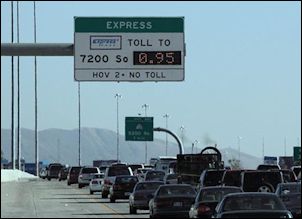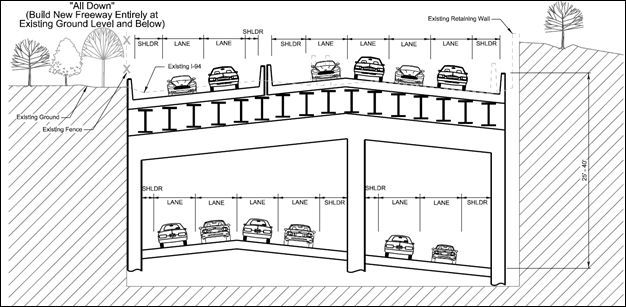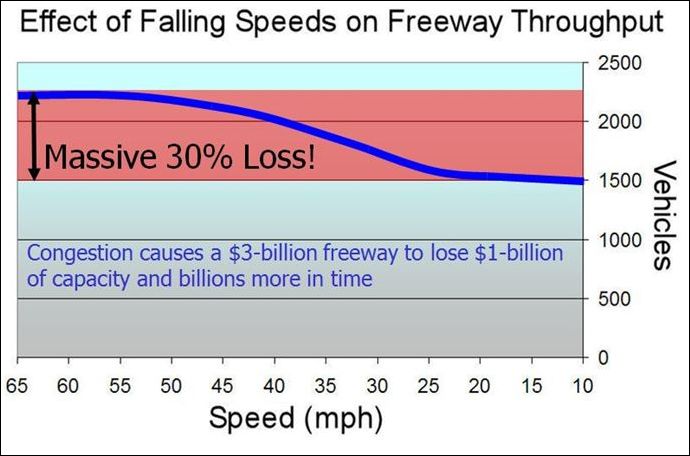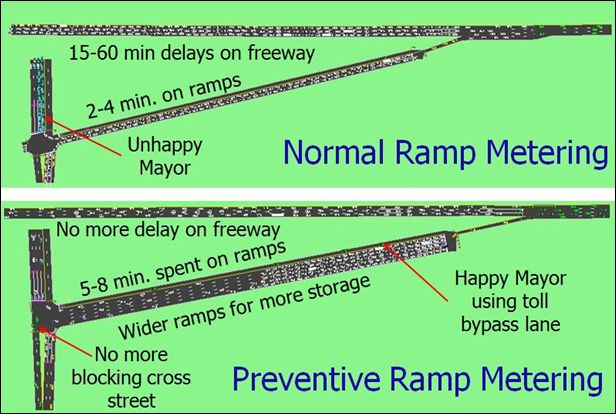by Michael Brown
This is the first part of a four-part series.
Part 1 ◊ Part 2
Part 3 ◊ Part 4
By many peoples’ reckoning, faster-running, free-flowing freeways are the enemy of environmental sustainability. But what if I told you of a strategy that would:
- Result in faster freeways without causing further sprawl?
- Have miniscule construction and maintenance costs?
- Double or triple transit ridership, as well as reduce auto trips on arterial streets?
- Break the cycle of “building our way out of congestion,” saving billions for other worthwhile efforts?
- Create thousands of permanent jobs, and strengthen the economy by billions?
- Be a market-driven solution that allowed people options for any given trip?
This article will show how faster freeways are entirely consistent with the goals of greening environment, improving public health, increasing economic productivity, and reducing land consumption.
“Fast and Free” has degraded to “Free but not Fast”
The early decades of the great American freeway experiment enjoyed freeways that were both “fast and free,” as in not tolled. Everyone loved it, including me. But recent decades have fallen into “free but not fast.” As traffic and congestion increased, we filled medians with new lanes to get back to fast and free. Then we paved shoulders, and that worked too – for a while. But adding lanes to increase throughput enabled millions of drivers to adopt far-flung lifestyles, creating more demand. Now that the easy solutions have been completed, the next generation of freeway improvements is incredibly expensive. Boston’s “Big Dig” project spent over $24 billion for about 8-miles of underground freeway! Now virtually every city has engaged in extremely costly freeway construction and many are talking seriously about their own “Big Dig” double-decker freeway projects.
Today Fast and Free is achievable only at sky-high prices and the “fast” will last only a short time. So consider a third possibility – Fast But Not Free.
Fast But Not Free — paying with money
Many transportation strategies strive for more transit and less driving. But the structure of transportation taxes creates a perception that driving is “free” while transit requires expensive fares or passes. Of course, drivers do pay at the pump, but that cost is well hidden. Moreover, taxes and fees tied to driving generate less revenue than the cost of building and maintaining roads and highways, and fuel taxes offer no incentive for someone to avoid being part of the 5-p.m. problem.
Congestion pricing brings out the pitchforks because it is perceived as double taxation. To that I would ask, “Would you rather be taxed $1 billion from a single gas tax? Or $900 million from a gas tax and the last $100 million from the 10% to 20% of drivers most responsible for expensive freeway construction?
The total collected can be the same, but the second option solves a problem. Rural residents, and even most urban dwellers, are not driving 40 miles on urban freeways at 5 p.m., so why ask them to pay higher fuel taxes so that a small minority can consume an excessive share of a Big Dig freeway? Congestion pricing generates revenue from the right people.
But, as important as that is from a moral and political standpoint, it is incidental to the higher purpose of ensuring our freeways won’t fail.
Fast but Not Free — paying with time
Another way to prevent congestion failure is to slow the rate of entry onto freeways to one-on for every one-off. Without ramp metering, for every vehicle getting off the freeway, there may be three trying to squeeze on, even though only one would fit. That causes gridlock, and it actually reduces freeway capacity by about 30%. Most cities have ramp metering to slow the rate of entry and modulate flow, but most systems still inadvertently allow too many on. In practice, metering delays system failure does not prevent it.
To ensure that freeways operate at maximum capacity, it would be necessary for ramp meters to slow the flow even more than most do now. Computer systems can easily figure out the right amount but there’s a political problem: Slower meters may cause stacking on cross streets, which causes the mayor to call the Department of Transportation to insist on speeding up the meters. Thus, we experience huge delays on the freeway because we’re unwilling to tolerate cross-street congestion and moderate delays on ramps.
What’s the solution? One is to add three, four, or even five lanes to the ramp. This way the cross streets won’t suffer, nor will the main freeway because enough cars can “park” on the ramp and await their turn. Drivers then “pay” by waiting 5 to 8 minutes on the ramp but they would avoid 15-minute to one hour delays on the main freeway.
For those unwilling to wait, could add a lane where you can pay a buck or two and avoid the long line. Put up a digital sign ahead of the ramp warning how long the wait is.Then people could choose to pay with either time or money, and short trips will stay off the freeway. It would take a huge educational campaign so that people understand they’re gaining a lot more time than they’re losing by waiting at ramp meters.
Why keep paying more when you could pay less?
No matter how you cut it, there are costs…
- You’re paying “big time!” If you’ve got Free But Not Fast freeways, you are already paying huge time costs of 15-60 minutes of delay per peak trip stuck in a multi-mile parking lot.
- You’re paying “big money!” If you solve the time problem by rallying big bucks for Free and Fast again, then you will pay huge construction dollars to Super-Size your freeway. Plus you’ll be paying with time again in just a few years.
- Pay minutes, gain hours! By “paying” just 5 to 8 minutes on the ramp, you gain 15-45 minutes per trip, adding up to many hours of your life back!
- Pay pennies, gain dollars! With distance-based pricing you will lose zero time, but instead pay a token cost for a high-demand slot on the freeway. In trade, add weeks if not months’ worth of time back to your life each year. Many people will turn that time into big $$ for the local economy.
Society usually opts for choice 2, but 3 and 4 offer far better return on investment. Pay just a little, and there is a good chance that you’ll even make your money back in reduced fuel consumption, wear and tear, and certainly in the value of your time.
Michael Brown is president of Metro Analytics of Salt Lake City, Utah.






